Thai stir-fried Rad Na Wide Noodles with Gravy is a savory and hearty dish with charred wide rice noodles with cooked Chinese broccoli and carrots and is then covered with a mouthwatering gravy sauce. It's the perfect comfort food all year round. Easy and quick, it comes together in 30 minutes!

Elevate Rad Na with homemade rice noodles, Sen Yai using this recipe.
Use Prik Nam Som or Thai chili oil and toasted Thai chili flakes, Prik Nam Pla or crushed toasted peanuts to add spice and zest to your Radna!
I'm baffled that Rad Na, a savory Thai noodle dish, is less popular outside Thailand. If I have to guess, all the lively cousin dishes like Pad Thai, Pad See Ew, and Pad Kee Mao-Drunken noodles are so popular that Rad Na gets left behind.
In Thailand, you'll see this Thai street food sold on nearly every block by street food vendors. Rad Na is often eaten for breakfast by the locals.
Jump to:
- What is Rad Na?
- Rad Na vs Pad See Ew
- Spellings of Rad Na or Lad Na
- Ingredients for making authentic Rad Na
- Protein Recommendations for Thai Rad Na
- Vegetables you can use for Ra Na
- How to make Thai Rad Na Recipe
- Garnishing options for Rad Na
- Helpful Kitchen Notes
- Frequently Asked Questions
- More Thai dishes you'll love
- Rad Na Wide Noodles with Gravy
What is Rad Na?
"Rad" in Thai means pouring over (something), while "Na" means face. So, it means to pour over the face, implying a thorough coverage of the entire surface of anything being poured over.
In this case, the stir-fried noodles are "Rad" and covered with gravy. The wide, flat rice noodles are cooked until charred, and then a perfectly balanced umami gravy is poured over them, making it the ultimate comfort food.
It is a full-flavored dish, usually eaten with some leafy vegetables and your choice of protein. Rad Na Recipe is a Thai-Chinese noodle dish with many flavors, techniques, and ingredients used in Chinese cooking.
Rad Na vs Pad See Ew
Thai Rad Na and Pad See Ew are savory stir-fried Thai noodles dishes made with chewy-soft wide rice noodles.
In the Rad na recipe, the noodles and the gravy are cooked separately and assembled before serving.
Pad See Ew on the other hand, the noodles, protein, and vegetables are stir-fried together with delicious savory sauces to create an easy one-dish meal.
Spellings of Rad Na or Lad Na
You will see a few spellings for this recipe. Expect to see some of these spellings and names of this dish in your local Thai restaurants. Rad Na, Rat Na, Rad nah, Rad Nar, Lad Na, Pad Lad Na, Kwe Tiau Radna, Lard Na, or Geuy Tiew Rad an.
They are all the same names, meaning the Thai flat rice noodles with gravy recipe!
Ingredients for making authentic Rad Na
There are 3 parts to this recipe. Don't be intimidated by the ingredient list. I will break them down and organize them into 3 groups so that you have a flow to help with ease and speed up the cooking process.
The prep time is a breeze once the ingredients are organized in groups!

Rad Na Noodles (Sen Yai or Wide Noodles)
Using fresh, wide rice noodles is crucial for this recipe as the soft, chewy, and charred noodles provide the base for this gravy.
- Fresh rice noodles. Use the Chow-Fun wide noodles. They come in several ways, depending on your local Asian market. Mine come in extra large sheets wrapped in a styrofoam packet in the refrigerated section. Learn more about Thai rice noodles here.
- They will almost always need microwaving for 1- 2 minutes to soften up and separate the sheets before cooking. Very important to do this. Check the kitchen notes section below for more noodles variety and suggestions.
- More garlic. I picked up This little extra tip from my favorite Lao restaurant years ago. This extra step helped season the noodles to the point where they could be eaten as a meal by themselves! So delicious. You might need to grab extra noodles just to snack on!
- Sweet dark soy sauce. This sauce gets a spotlight because it helps flavor the noodles and gives them a golden brown color. Don't confuse them with the black soy sauce. They are similar but not the same thing. See the image above for a photo reference. Learn more about Thai sauces here.
- Soy sauce. Add 1 tablespoon of soy sauce to season the noodles.
- Oil. The large sheet noodles are typically well-oiled, so use your discretion with how much extra cooking oil you'll need for frying the noodles.
Protein options for Lad Na
Tenderizing the meat is essential if using beef, chicken, or pork. A little baking soda helps break down the meat fibers, so the meat is tender and velvety when stir-frying. This is a common technique used by many Asian restaurants when stir-frying meat.
- Beef. Use stir-frying beef and cut it into long thin pieces around 2-inch each. Cutting the meat into small pieces also helps cook quicker too.
- Baking soda. It helps tenderize the meat for the soft, silky flavor.
- Water. Just a couple of cold water tablespoons will help break the baking soda into the meat slices.
- Garlic. Add an extra depth of flavor to the meat, making this dish full of layers of flavors! Divide the garlic into 2 parts, one for the beef and the other for the stir-fried noodles.
- Oil. Use neutral oil like avocado, canola, or vegetable oil for stir-frying the beef.
Rad Na Gravy Recipe
Rad Na sauce is where all the savory magic takes place! This is where the sauces, stock, and seasoning are all coming together for the gravy to slather all over the rice noodles!
- Oyster sauce. Adds the umami velvety flavor.
- Light soy sauce. Use regular soy sauce as a substitute
- Soybean paste. It's a fermented yellow bean sauce common in many dishes in Thai cooking. It's essential to make this recipe authentic. Find these at your local Asian grocery stores.
- Rice vinegar. It adds a tanginess to help balance the sweet and salty flavor.
- Sugar. Use white, coconut, or monk fruit sugar. It rounds out the salty flavor.
- Ground white pepper. A unique flavor that will elevate your Rad Na. Black pepper is okay as a substitute.
- Tapioca starch. Or tapioca flour. This is the thickening agent we need to make Rad Na gravy. Corn starch is a good substitute.
- Chicken broth. Use any broth or stock of your choice. Water will work, too, but you will need to add extra sauces and seasoning to help with the lack of flavors of broth or stock.
- Chinese broccoli, also called Gai Lan. Slice the stems into long, thin pieces,, around 2-inch pieces. The leafy parts can be cut into larger pieces, 3-4 inches. They will wilt into small pieces when cooked. See kitchen notes for vegetable substitutes. Regular broccoli works great as a substitute.
- Carrot. Slice long and thin, around 2-inch pieces each. Carrot chips are super handy for this recipe.
Protein Recommendations for Thai Rad Na
I have tasted lots of Rad Na with different proteins, but my favorites are beef, pork, and seafood! You can choose whatever choice of protein suits your taste buds.
If using tofu or seafood, remember that seafood doesn't take as long to cook as the other types of meat. Reduce the cooking time of those lighter proteins to half.
Vegetables you can use for Ra Na
This easy Rad Na recipe is versatile regarding what vegetables you can use. Traditionally, Chinese broccoli, carrots, and onions are used, helping to keep the recipe simple, while the focus is on the noodles and gravy.
Since the recipe can be flexible, I recommend using the following vegetables if Chinese broccoli is unavailable.
Use Broccoli, Snow peas pods, Kale, Asparagus, Bok Choy, Carrots, Sweet Onion, Water Chestnuts, Fresh baby corn, and Bell peppers.
These vegetables are perfect if you want to make a vegetarian Rad Na.
How to make Thai Rad Na Recipe
Step 1. Tendering the meat. Mix the beef, baking soda, and water in a small bowl and lightly massage with your fingers until the baking soda dissolves.
Let sit at room temperature for about 10 minutes while you prep the other ingredients.

Step 2. Make the Rad Na sauce. Make the sauce for the grave in a large bowl by adding oyster sauce, soy sauce, soybean paste, vinegar, sugar, white pepper, tapioca starch, and stock.
Stir well and set aside.
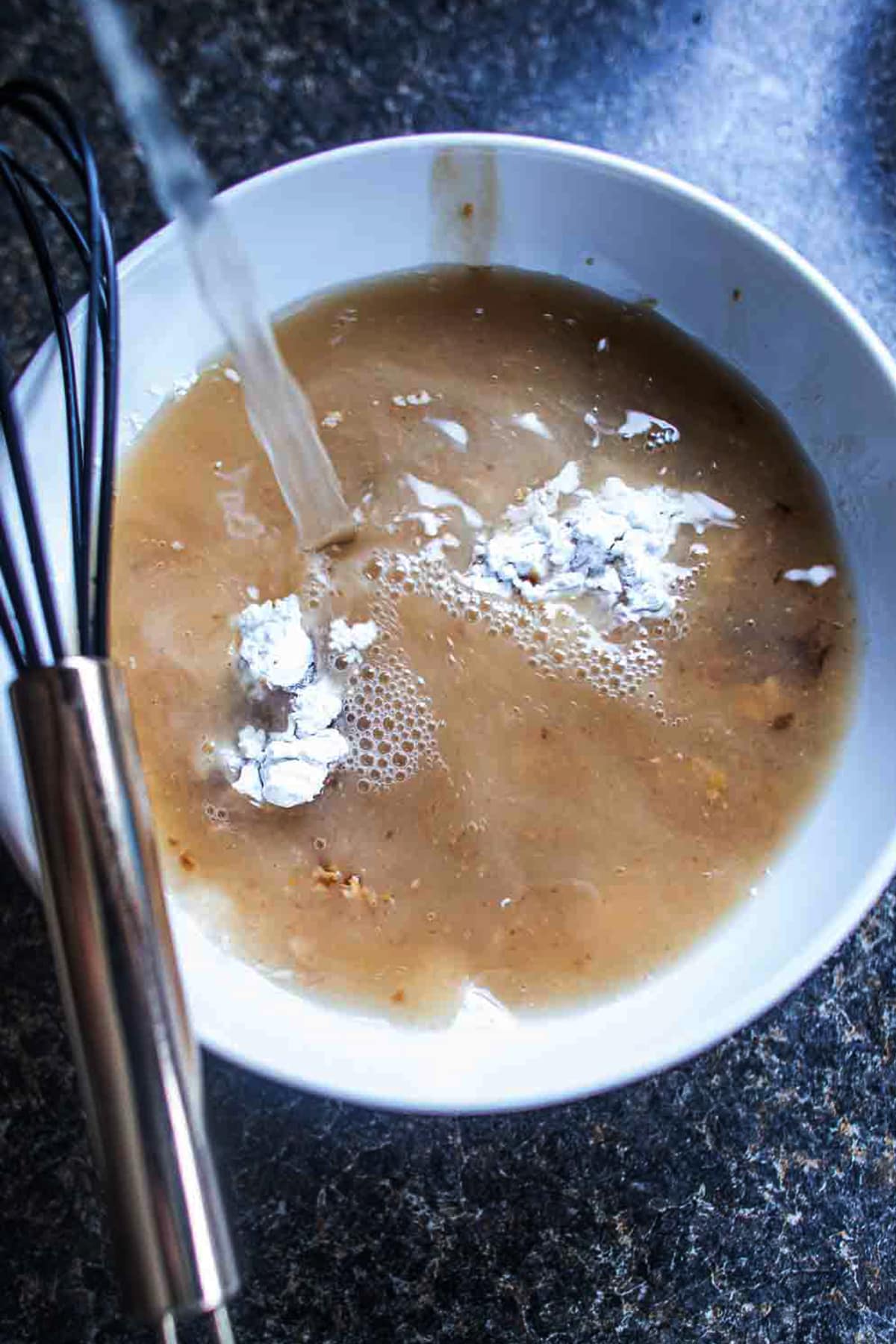
Step 3. Prepare the noodles. If using large sheets, cut noodles into 2-3 inches wide and 6 inches long. Microwave the noodles for 1-2 minutes until soft enough to separate them.
Be careful when handling hot noodles straight out of the microwave. Set aside the strands until ready.
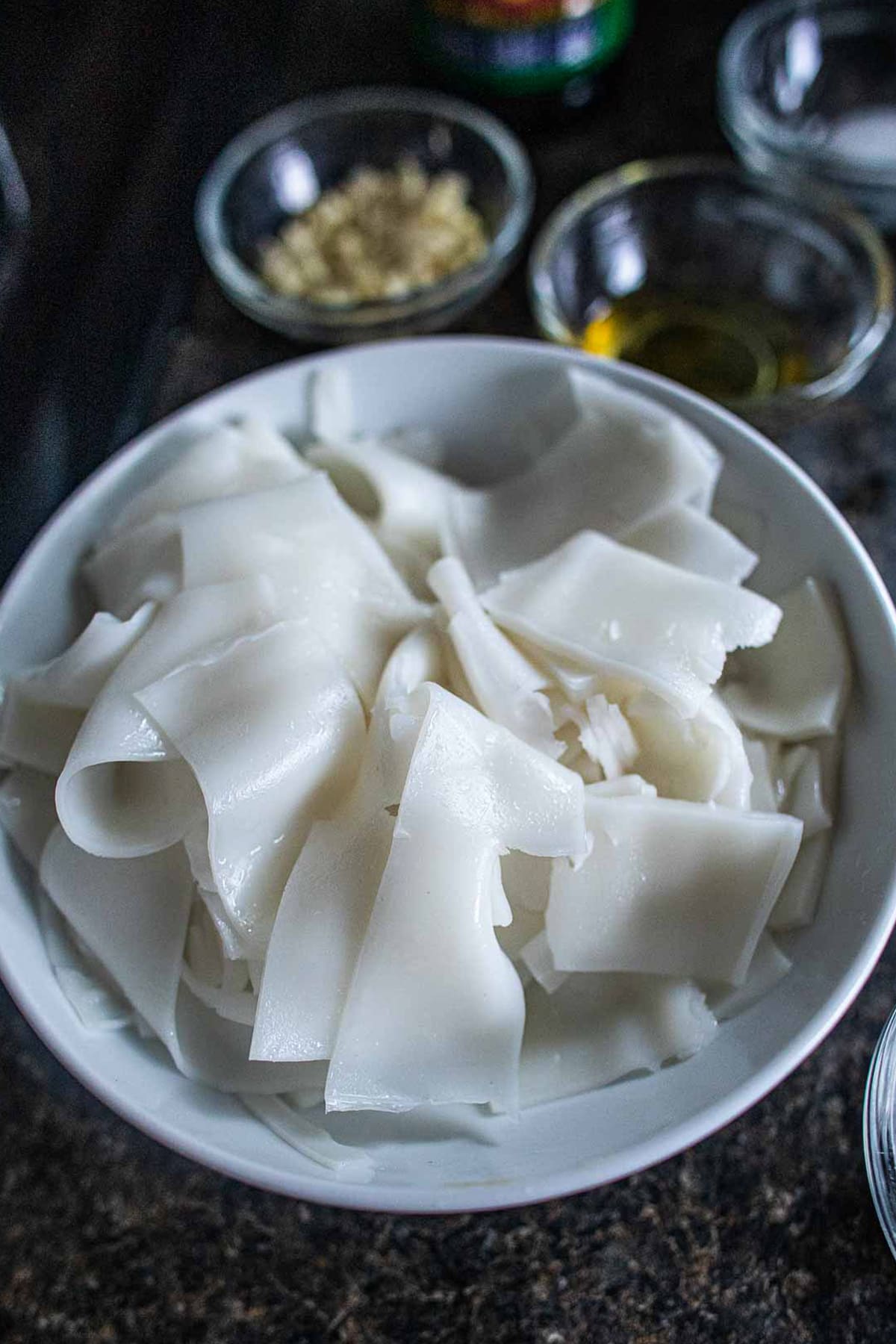
Step 4. Make the fried noodles. Set a wok or large pan on high heat, add 1 tablespoon of oil, then add the garlic and noodles to the hot oil. Pour the sweet, dark soy sauce over the noodles, then spread the noodles out as much as possible on the pan surface.
Don't touch it for about 12 minutes. We're letting the noodles char a bit for the extra flavors.
Gently flip the noodles to cook the other side. Let the noodles charred to a light golden brown for about 2 more minutes.
Remove from heat and place into individual serving plates (3-4 plates) while waiting for the gravy to be ready.
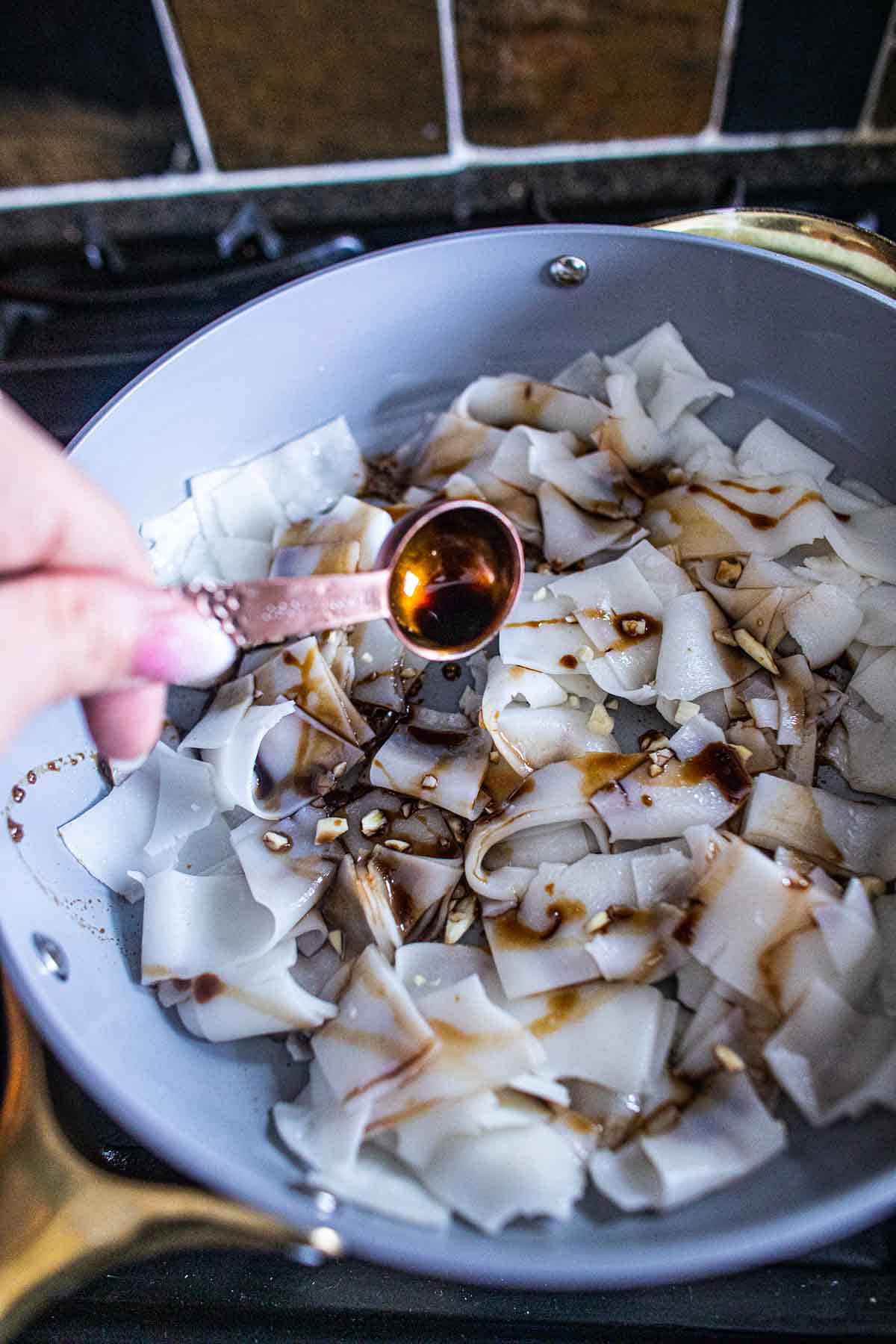
Step 5. Sear the beef. Add the rest of the oil to the same pan, turn the heat to medium-high. Add the beef and garlic to the hot pan, and cook for 2 minutes or until the beef is lightly browned but not fully cooked.
Stir a couple of times.
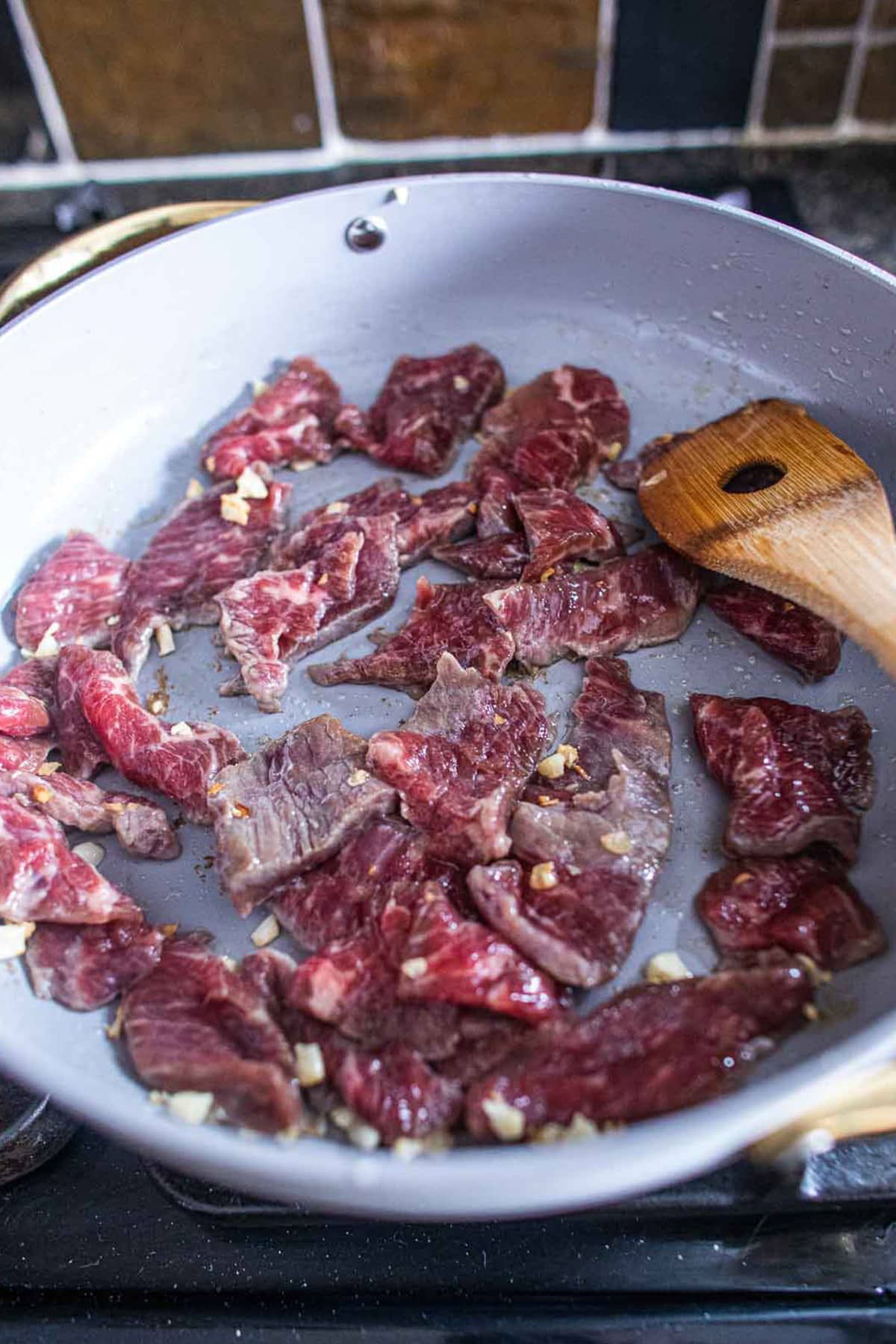
Step 6. Add the veggies. Add carrot and only the stems of the Chinese broccoli. Cook for 2 minutes until lightly tender and stir.
We'll save the leafy part for the end. They cook very quickly.

Step 7. Add the gravy mixture to the pan. Before adding to the beef, use a fork or whisk to stir the bowl lightly to dissolve any lumps from the tapioca starch.
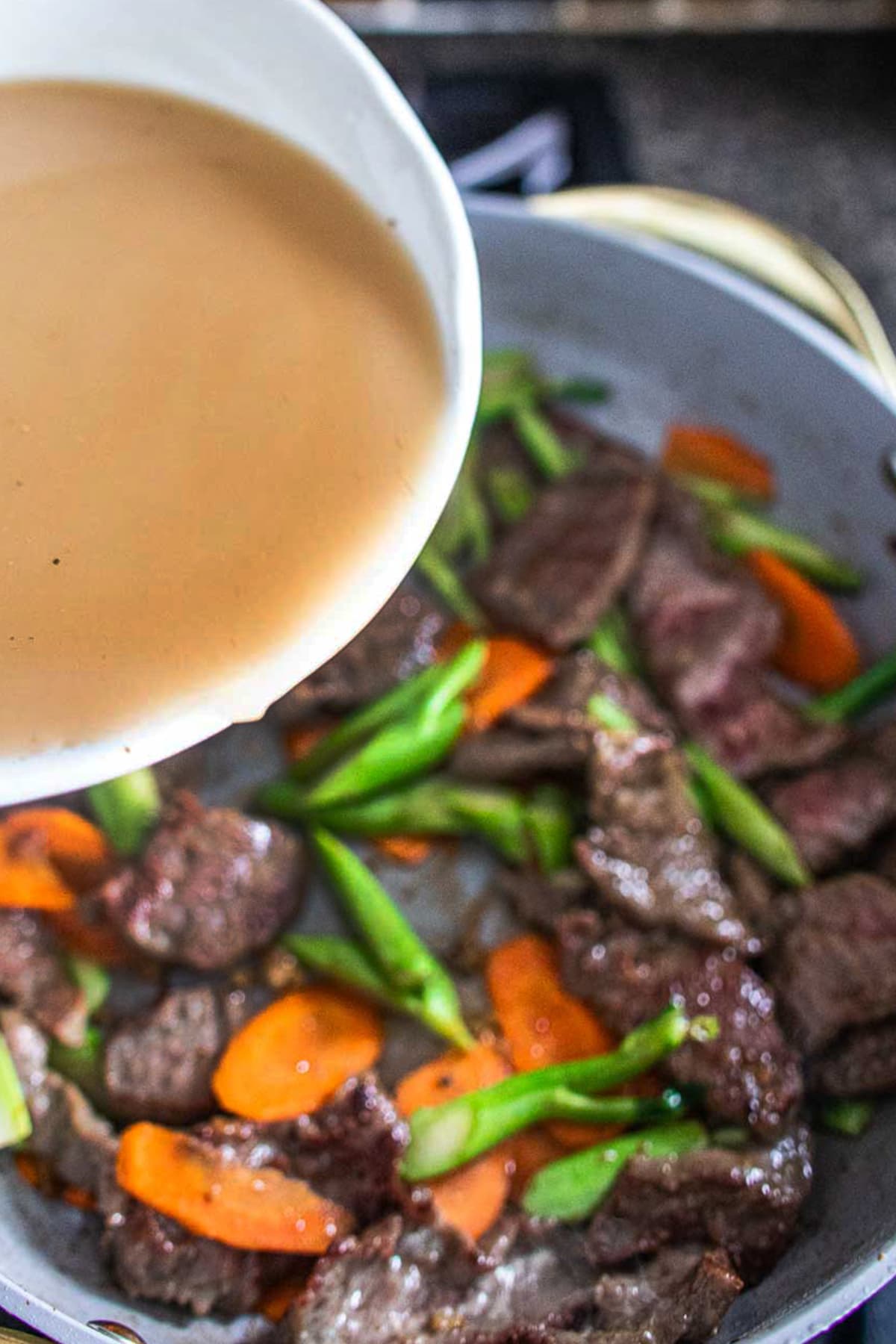
Step 8. Add the leafy parts of the Chinese broccoli, stir, and cook until the gravy thickens. Stir everything well in the wok and cook until the gravy thickens, about 3-4 minutes.
Turn the heat off and scoop a generous amount of the gravy Rad Na sauce into each noodle platter. Serve immediately!
Enjoy the best Rad Na, your new Thai favorite noodle dish! (;


Garnishing options for Rad Na
When eating Rad Na in Thailand, you usually have a handful of garnishing options at your table. Listed below are some of the standard condiments you’d find on the food stall tables on the streets of Thailand.
Sprinkle these fun garnishes as needed with every few bites with your Rad Na. You can customize the flavors here with more heat, sour, salt, and sweetness. Enjoy!
- Thai Chili vinegar sauce. Prik Nam Som. This tangy sauce will last up to 3-4 weeks in the fridge.
- Thai chili oil. For extra heat for spicy food lovers.
- Pickled Jalapenos. Slice it into thin, small slices so it's not too spicy when biting into it.
- Thai chili flakes. As needed for some kick!
- Fried garlic or shallot. It is a must for added flavors and fragrances. Yum!
- Ground white pepper. It gives it a very distinctive Thai flavor that sets this dish apart.
- Fish sauce. For an extra taste of salty umami flavor. As needed, of course.
- White granulated sugar. To help round out the rad Na's spicy, salty, and tangy taste.

Helpful Kitchen Notes
- Use a non-stick pan for making this dish, especially when frying the noodles.
- If using a wok, especially at high heat, the noodles stick too much to the pan, causing the fragile noodles to break up too easily into small bits.
- Add oil to the pan to loosen up the noodles if necessary.
- Use a large wok or skillet to hold in all the gravy mixture, the vegetables, and the meat.
- Eat your Rad Na for breakfast! Try it. It's hearty and will keep you full for a long while.
- If your Asian market doesn't carry the wide rice noodles, use the widest dry ones you can find and follow the packet instructions before using with stir-frying.
- I've used frozen cut noodles before, and they work great. Be sure to cook them as per the packet directions.
- Buy extra noodles! (: Especially if you can find fresh rice noodles. With this recipe technique, the noodles are delicious on their own! Perfect for my little picky eaters. (;
Frequently Asked Questions
No. They are not the same dish. However, both recipes use wide rice noodles with a couple of the same sauces for seasoning. The flavors and textures are different.
The Thai Rad Na recipe gravy is made from broth or stock, seasoned with different sauces, and thickened with tapioca, corn, or potato starch.
Rad Na is best eaten fresh off the wok with the warm savory gravy poured over the cooked meat and vegetables. You can cook the rice noodles ahead of time but best to make the the Rad Na gravy sauce fresh.
The fermented yellow bean paste is a key ingredient for this Thai noodles recipe. You can substitute miso paste instead of bean paste is not availble but the flavors and texture will change slightly.
Rad Na has a special place in my heart and hopefully in your kitchen soon, too! I love that Rad Na is not so sweet, yet it still holds a fair taste of a stir-fry dish's savory and umami flavors.
The charred and chewy wide noodles are enough for a meal! You might need to buy extra noodles because you can't stop eating them alone!
More Thai dishes you'll love
- Pad Prik Khing recipe with shrimp and green beans
- 5-minute satay peanut sauce
- Pad Kee Mao
- Thai basil stir fry
- Bean thread noodles stir fry, Pad Woon Sen
- Sticky rice
- Pad Mee, Thai rice vermicelli
- Kaffir lime leaves and substitute
- Different types of Thai noodles
** Love a recipe you've tried? Please leave a 5-star rating in the recipe card below and a review in the comments section further down the page. Or follow me on Facebook, Pinterest, or Instagram! **
Print
Rad Na Wide Noodles with Gravy
- Total Time: 30 minutes
- Yield: 4
- Diet: Low Lactose
Description
Thai stir-fried Rad Na Wide Noodles with Gravy is a savory and hearty dish with charred wide rice noodles with cooked Chinese broccoli and carrots and is then covered with a mouthwatering gravy sauce. It's the perfect comfort food all year round. Easy and quick, it comes together in 30 minutes!
Ingredients
The Rad Na Noodles
Using fresh, wide rice noodles is crucial for this recipe as the soft, chewy, and charred noodles provide the base for this gravy.
- 1 pound fresh wide noodles. Use the chow-fun wide noodles.
- 2 tablespoons garlic.
- 1 tablespoon sweet dark soy sauce.
- 1 tablespoon soy sauce.
- 1 tablespoon oil.
The protein
- 1 pound beef, thinly sliced into 2-inch pieces. Use stir-frying beef cuts like sirloin, flanks, and skirt steak.
- 1 teaspoon baking soda.
- 1 tablespoon water.
- 1 tablespoon garlic, minced.
- 2 tablespoons oil. Use neutral oil like avocado, canola, or vegetable oil for stir-frying the beef.
The Rad Na Sauce
- 2 tablespoons oyster sauce. Adds the umami velvety flavor.
- 2 tablespoons light soy sauce. Use regular soy sauce as a substitute
- 1 ½ tablespoons soybean paste. It's a fermented yellow bean sauce common in many dishes in Thai cooking. It's essential to make this recipe authentic. Find these at your local Asian grocery stores.
- ½ tablespoon rice vinegar. Adds a tanginess to help balance the sweet and salty flavor.
- 1 tablespoon sugar. Use white, coconut, or monk fruit sugar.
- 1-2 teaspoon ground white pepper.
- 3 tablespoons tapioca starch. Or tapioca flour.
- 3 cups chicken broth. Use any broth or stock of your choice.
- 8 ounces of Chinese broccoli. Slice the stems into long, thin pieces, around 2-inch pieces. Cut the leafy parts into larger pieces, 3-4 inches.
- 1 cup carrot. Slice long and thin, around 2-inch pieces each. Carrot chips are super handy for this recipe.
Instructions
- Mix the beef, baking soda, and water in a small bowl and lightly massage with your fingers until the baking soda dissolves. Let sit at room temperature for about 10 minutes while you prep the other ingredients.
- Make the gravy mixture. Make the sauce for the grave in a large bowl by adding oyster sauce, soy sauce, soybean paste, vinegar, sugar, white pepper, tapioca starch, and stock. Stir well and set aside.
- Prepare the noodles. If using large sheets, cut noodles into 2-3 inches wide and 6 inches long. Microwave the noodles for 1-2 minutes until soft enough to separate the noodles. Be careful when handling hot noodles straight out of the microwave. Set aside the strands until ready.
- Make the fried noodles. Set a wok or large pan on high heat, add 1 tablespoon of oil, then add the garlic and noodles to the hot oil. Pour the sweet, dark soy sauce over the noodles, then spread the noodles out as much as possible on the pan surface. Don't touch it for about 12 minutes. We're letting the noodles char a bit for the extra flavors. Gently flip the noodles to cook the other side. Let the noodles charred to a light golden brown for about 2 more minutes. Remove from heat and place into individual serving plates (3-4 plates) while waiting for the gravy to be ready.
- Add the rest of the oil to the same pan, turn the heat to medium-high, add the beef and garlic to the hot pan, and cook for 2 minutes or until the beef is lightly browned but not fully cooked. Stir a couple of times.
- Add carrot and only the stems of the Chinese broccoli. Cook for 2 minutes until lightly tender and stir. We'll save the leafy part for the end. They cook very quickly.
- Add the gravy mixture to the pan. Before adding to the beef, use a fork or whisk to lightly stir the bowl before adding to dissolve any lumps from the tapioca starch.
- Stir everything well in the wok and cook until the gravy thickens about 3-4 minutes. Turn the heat off and scoop a generous amount of the gravy into each noodle platter. Serve immediately! Enjoy the best Rad Na, your new Thai favorite noodle dish! (;
Garnishing options
- Chili vinegar. Make your own by mixing 4-10 finely diced chilis with ¼ cup rice or white vinegar, and let it soak for a bit. It will last up to 3-4 weeks in the fridge.
- Pickled Jalapenos.
- Thai chili flakes
- Fried garlic or shallot
- Ground white pepper
- Fish sauce
- White granulated sugar
Notes
- Use a non-stick pan for making this dish, especially when frying the noodles. If using a wok, especially at high heat, the noodles stick too much to the pan, causing the fragile noodles to break up too easily into small bits. If necessary, add a little oil to the pan to loosen up the noodles.
- Use a large wok or skillet to hold in all the gravy mixture, the vegetables, and the meat.
- Eaten as a breakfast meal, try it. It's so hearty and will keep you full for a long while.
- If your Asian market doesn't carry the wide rice noodles, use the widest dry ones you can find and follow the packet instructions before using with stir-frying.
- I've used frozen cut noodles before, and they work great. Be sure to cook them as per the packet directions.
- Buy extra noodles! (: Especially if you can find fresh rice noodles. With this recipe technique, the noodles are delicious on their own! Perfect for my little picky eaters. (;
** Thank you so much for visiting my blog! This is truly a passion for me. If you have enjoyed these recipes and appreciate the hard work I put into them, I would love it if you would share them with your friends! Your recommendation is the highest review I could hope for, and I’d appreciate it! **
- Prep Time: 15
- Cook Time: 15
- Category: beef recipe, noodles, stir fry
- Method: Stir-fry
- Cuisine: Thai





Suwanee says
Happy you loved it, Lizie!
Lizie says
Wonderful recipe !! Thank you Suwanee!
Tammy says
We made your Rad na recipe this weekend, twice. 😄 Had lots of leftover noodles and Chinese broccoli. One with beef and one with seafood. Both incredible! Thanks, Suwanee for your detailed instructions and photos. Very helpful!
Suwanee says
Thank you so much! I love this recipe too!
Erika says
Incredible tasty and hearty! Loved the wide noodles and vegetables used in the recipe. Extra extra tasty!